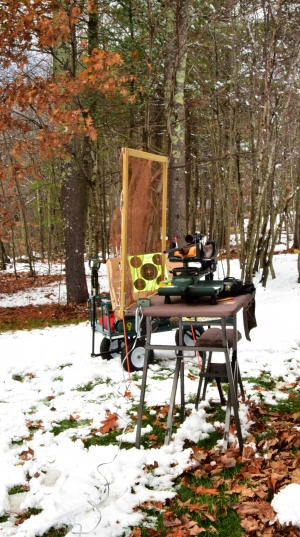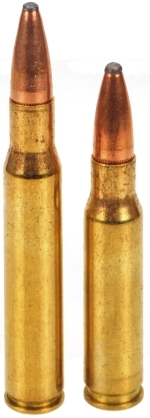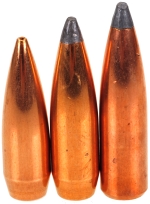
We had our second minor snow fall of the season, but the temperature dropped substantially to a low of 27ºF and a high of 43ºF. Somehow, the 27ºF is when I need to work outside and then I get to watch the snow melt from inside when it is 43ºF. Without snow, hauling things over to the range is pretty easy. A garden wagon with a few modifications can haul rests, targets, firearms and ammo, a few tools, and a chronograph in an orderly fashion. A light shooting bench with brass catcher can be walked into position with the aid of a handtruck. About 10 minutes of set up.

With a little snow on the ground, the wagon with a hundred pounds of gear turns into a snow plow and a patch must be cleared for the bench. Fingers get numb, gusting winds blow targets around and the trek back and forth to set up and pull targets can be an adventure.
I find that a few inches of fluffy snow over a still very green lawn with leaves, particularly on a steep slope, can be like walking… or should I say sliding on ball bearings. It will get you to the targets faster, but you’re not always standing when you get there. In any event, other than putting an FX format lens on a DX format camera and wondering why it didn’t auto focus, things went pretty good.
My dream is to retire someday to a warm climate and have a range with a swimming pool and a big screen… maybe one of those Mr. Magoo electric carts to drive back and forth to change targets. Perhaps a young, naive and impressionable assistant to jot down chronograph readings and to feign being impressed every time I shot a sub MOA group. It’s a work in progress.
Initially, factory ammo was shot with the rifle parked in a sled; factory ammo is available to everyone and using a sled dramatically reduced the influence of shooter’s skills… me. The ammunition was Remington Express Core-Lokt, 180 and 150 grain PSP.
The first 6 shots out of the rifle went to chronograph readings, 3 of each ammo type; 180 grain @ 2,688 fps, 150 grain @ 2,848 fps from the Browning’s 22″ barrel. The ammunition is factory rated with a 24″ test barrel at 2,700 fps and 2,910 fps respectively.

Above, other than approximate sighting in, individual ammo types were not zeroed, but shot to same point of aim when checking group size performance. The 180 grain shot the 3/4″ group on the left, the 150 grain shot 1 1/8″ with me taking ownership for that wandering shot. Accuracy did improve with use, however, these were shots 7 – 12 out of the new barrel and I think performance was admirable.
The much maligned 30-06 Springfield
The 30-06 Springfield is often defined as a cartridge that is needlessly long and offers no advantage of consequence over the 308 Winchester. That assessment is levied mostly by people who own 308 Winchesters. Personally, I find 308 Winchester fans much like Justin Bieber fans; fanatical and mostly girls. The 308 Winchester is another short round fad that surely will burn out any day now.
 The reason the 308 Winchester had prospered is wide spread adoption by U.S. and NATO forces as a primary small arms cartridge feeding many small arms actively in use and availability of cheap ammo. Notice that ballistic performance is not a point of reference. The notion that the 308 Winchester and 30-06 Springfield are ballistically synonymous is silly. The 30-06 Springfield holds 68 grains of powder compared to 56 grains for the 308 Winchester; a 21% increase in capacity.
The reason the 308 Winchester had prospered is wide spread adoption by U.S. and NATO forces as a primary small arms cartridge feeding many small arms actively in use and availability of cheap ammo. Notice that ballistic performance is not a point of reference. The notion that the 308 Winchester and 30-06 Springfield are ballistically synonymous is silly. The 30-06 Springfield holds 68 grains of powder compared to 56 grains for the 308 Winchester; a 21% increase in capacity.
In addition to additional capacity, the 308 Winchester is a truncated cartridge, chambered in short action firearms that force long bullets to be seated deeply. Deep seating displaces even more of the 308 Winchester’s net case capacity. The 308 Winchester is a compromised cartridge that requires no such compromise for civilian applications. Military applications, Soldier of Fortune wannabees, doomsday preppers, Gunsite weekend warriors? I can’t say…. and I don’t care. For hunting and handloading, the 30-06 Springfield holds an advantage with no downside.
On the other side of the fan spectrum are the magnum only cartridge bear and moose hunters. In response I would offer this quote from the Alaskan Department of Fish and Game, “Most experienced guides prefer that a hunter come to camp with a .270 or .30-06 rifle they can shoot well rather than a shiny new magnum that has been fired just enough to get sighted-in. If you are going to hunt brown bear on the Alaska Peninsula or Kodiak Island, a .30-06 loaded with 200- or 220-grain Nosler® or similar premium bullet will do the job with good shot placement”.
If you have the opportunity, Alaskan Department of Fish and Game site’s page on firearms selection makes for a good read. The short response is that the 30-06 Springfield is more than enough gun for any North American hunting. So why is the Real Gun’s site loaded with articles with magnum cartridges as the subject? Because they are interesting and fun and, for the minority of people who can actually shoot them with confidence, they offer some advantage. However, they are like race cars and no one, even a race car driver, wants to drive one back and forth to work every day.
 Three that I like for the 30-06 Springfield
Three that I like for the 30-06 Springfield
Left to right: Sierra 135 Grain HPBT, Sierra 165 Grain SPBT, Nosler 180 Grain Partition Spitzer. The 135 Grain was actually developed for small capacity 30 caliber cartridges, but it has worked well for me on medium size varmints and it’s a low recoil load for recreational target shooting.
How did I get started with this misapplication of this bullet? You know, the usual… You’re handloading, bad weather has you stuck indoors, you’re looking at your reloading bench and all these neat little parts and you begin to think, “Hey, I wonder what would happen if I…” Always a valid approach as long as considered and considerable thought comes before action.
The 165 Grain is a terrific bullet for use on deer size and similar size gamet. Good velocity and good longer range performance. The 180 Grain Is a tough, controlled expansion bullet that holds together during penetration, retaining bullet weight. It is also one of the slicker BC Partitions from Nosler, offering good longer range performance.
 |
Warning: Bullet selections are specific, and loads are not valid with substitutions of different bullets of the same weight. Variations in bullet material and length will alter net case capacity, pressure and velocity results. Primer selection is specific and primer types are not interchangeable. These data represents maximum loads in our firearms and test equipment and may easily be excessive in other applications. All loads should be reduced by 3%, and developed following safe handloading practices as represented in established reloading manuals produced by component manufacturers. Presentation of these loads does not constitute a solicitation for their use, nor a recommendation.
|
||||||||||||||||||||||||||||||||||||||||||||||||||||||||||||||||||||||||||||||||||||||||||||||||||||||||||||||||||||||||||||||||||||
|
|||||||||||||||||||||||||||||||||||||||||||||||||||||||||||||||||||||||||||||||||||||||||||||||||||||||||||||||||||||||||||||||||||||
The Browning X Bolt performed well with handloads, regardless bullet weight. More probably could have been done with Superformance powder, but what is here compares favorably to other handload performance for 22″ barrel firearms.
Cold, tired and done for the day…
The Browning X-Bolt is a hunter’s rifle with a traditional firearm look. It’s fit and finish reflects quality, but not the type of fragility of finish that would make an owner fearful of exposing the rifle to a hunting environment. It is an accurate sporter, not a target rifle, but a degree of accuracy that would cover a person with adequate shooting skills out well beyond 300 yards. Chambered for a cartridge like the 30-06 Springfield or any of the heavier rounds, it is all the rifle a North American hunter would need.

Email Notification